Discover 35 hidden attractions, cool sights, and unusual things to do in Vancouver (Canada). Don't miss out on these must-see attractions: Stanley Park, Science World, and Museum of Anthropology. Also, be sure to include Bloedel Floral Conservatory in your itinerary.
Below, you can find the list of the most amazing places you should visit in Vancouver (British Columbia).
Table of Contents
Stanley Park
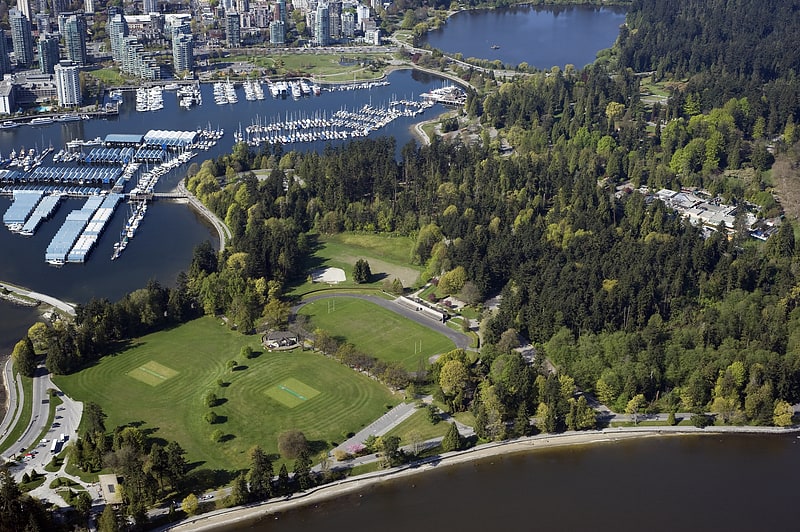
Sprawling urban park with scenic seawall. Stanley Park is a 405-hectare public park in British Columbia, Canada that makes up the northwestern half of Vancouver's Downtown Peninsula, surrounded by waters of Burrard Inlet and English Bay. The park borders the neighbourhoods of West End and Coal Harbour to its southeast, and is connected to the North Shore via the Lions Gate Bridge. The historic lighthouse on Brockton Point marks the park's easternmost point. While it is not the largest of its kind, Stanley Park is about one-fifth larger than New York City's 340-hectare Central Park and almost half the size of London's 960-hectare Richmond Park.
Stanley Park has a long history. The land was originally used by Indigenous peoples for thousands of years before British Columbia was colonized by the British during the 1858 Fraser Canyon Gold Rush and was one of the first areas to be explored in the city. For many years after colonization, the future park with its abundant resources would also be home to non-Indigenous settlers. The land was later turned into Vancouver's first park when the city incorporated in 1886. It was named after Lord Stanley, 16th Earl of Derby, a British politician who had recently been appointed Governor General. It was originally known as Coal Peninsula and was set aside for military fortifications to guard the entrance to Vancouver harbour. In 1886 Vancouver city council successfully sought a lease of the park which was granted for $1 per year. In September 1888 Lord Stanley opened the park in his name.
Unlike other large urban parks, Stanley Park is not the creation of a landscape architect, but rather the evolution of a forest and urban space over many years. Most of the manmade structures present in the park were built between 1911 and 1937 under the influence of then superintendent W.S. Rawlings. Additional attractions, such as a polar bear exhibit, aquarium, and a miniature train, were added in the post-war period.
Much of the park remains as densely forested as it was in the late 1800s, with about a half million trees, some of which stand as tall as 76 metres (249 ft) and are hundreds of years old. Thousands of trees were lost (and many replanted) after three major windstorms that took place in the past 100 years, the last in 2006.
Significant effort was put into constructing the near-century-old Vancouver Seawall, which can draw thousands of people to the park in the summer. The park also features forest trails, beaches, lakes, children's play areas, and the Vancouver Aquarium, among many other attractions. On June 18, 2014, Stanley Park was named "top park in the entire world" by TripAdvisor, based on reviews submitted.[1]
Address: Stanley Park Dr, V6G 3E2 Vancouver
Science World
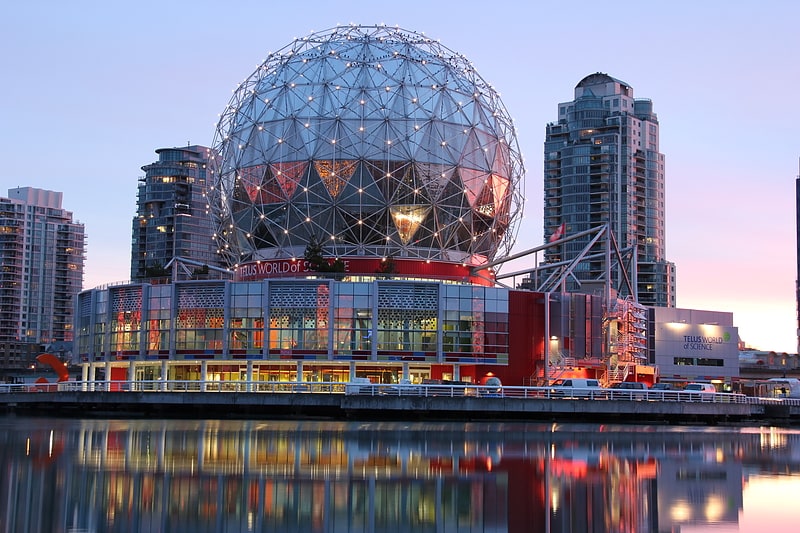
Museum in Vancouver, British Columbia. Science World is a science centre run by a not-for-profit organization of the same name in Vancouver, British Columbia, Canada. It is located at the end of False Creek and features many permanent interactive exhibits and displays, as well as areas with varying topics throughout the years.
Prior to the building being handed over to Science World by the city government in 1987, the building was built as Expo Centre for the Expo 86 world's fair. Following the end of Expo 86, the building was re-purposed as a science centre. The science centre opened on May 6, 1989, as Science World. From 2005 to 2020, the museum was branded as Science World at Telus World of Science, before it reverted to its original name.[2]
Address: 1455 Quebec St, V6A 3Z7 Vancouver
Museum of Anthropology
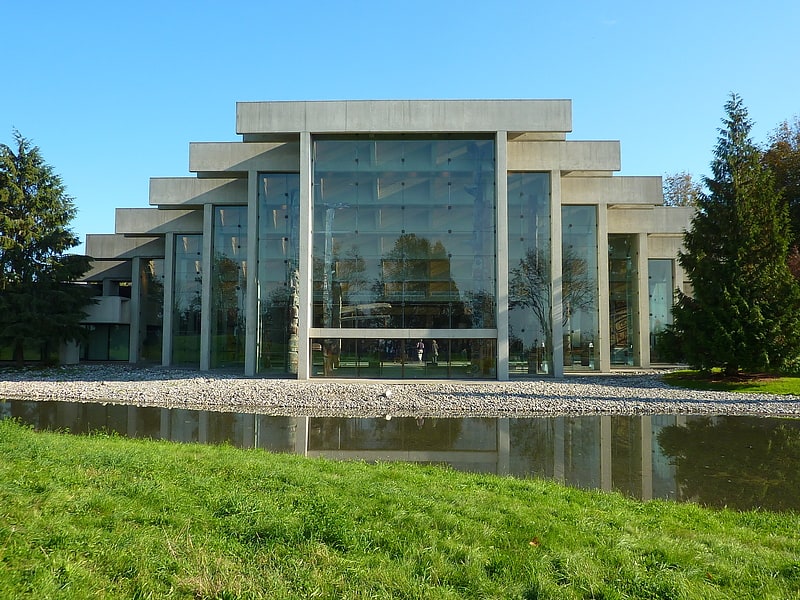
Cultural artworks from around the world. The Museum of Anthropology at the University of British Columbia campus in Vancouver, British Columbia, Canada is renowned for its displays of world arts and cultures, in particular works by First Nations of the Pacific Northwest. As well as being a major tourist destination, MOA is a research and teaching museum, where UBC courses in art, anthropology, archaeology, conservation, and museum studies are given. MOA houses close to 50,000 ethnographic objects, as well as 535,000 archaeological objects in its building alone.[3]
Address: 6393 NW Marine Dr, V6T 1Z2 Vancouver
Bloedel Floral Conservatory
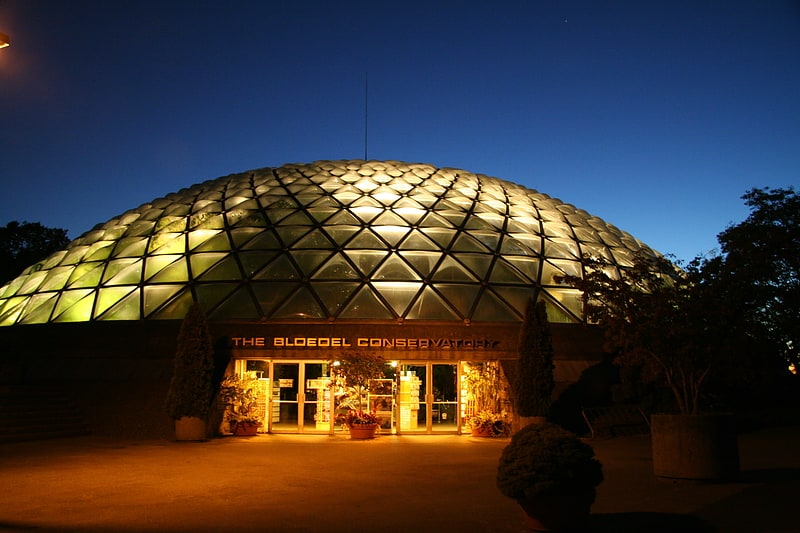
Domed aviary and greenhouse in the park. The Bloedel Floral Conservatory in Vancouver, British Columbia, Canada, is a conservatory and aviary located at the top of Queen Elizabeth Park.[4]
Address: 4600 Cambie St, V5Y 2M4 Vancouver
Vancouver Aquarium

Educational aquatic exhibits and shows. The Vancouver Aquarium is a public aquarium located in Stanley Park in Vancouver, British Columbia, Canada. In addition to being a major tourist attraction for Vancouver, the aquarium is a centre for marine research, ocean literacy education, conservation and marine animal rehabilitation.
The Vancouver Aquarium was one of the first facilities to incorporate professional naturalists into the galleries to interpret animal behaviours. Prior to this, at the London Zoo Fish House, naturalists James S. Bowerbank, Ray Lankester, David W. Mitchell and Philip H. Gosse (the creator of the word aquarium) had regularly held "open house" events, but the Vancouver Aquarium was the first to employ educational naturalists on a full-time basis. Aquarium research projects extend worldwide, and include marine mammal rescue and rehabilitation.
On August 9, 2010 Prime Minister Stephen Harper and B.C. Premier Gordon Campbell announced capital funding of up to $15 million. The province would donate $10 million in funding over the next three years to help pay for a planned expansion of the 54-year-old facility, Premier Gordon Campbell said. Harper added that Ottawa would hand over up to $5 million to the aquarium for infrastructure upgrades. The aquarium, however, remained nonprofit organization. The property is owned by the City of Vancouver and rented to the aquarium for $40,000 a year since 1991 (prior to which it was $1 per year).
In October 2009 the Vancouver Aquarium was designated as a Coastal America Learning Center by the US Environmental Protection Agency. As the first Learning Center in Canada, this designation is intended to strengthen the Canadian/U.S. partnership for protecting and restoring shared ocean resources.
On August 31, 2020, the non-profit announced on Facebook that due to the financial stresses caused by the ongoing COVID-19 pandemic, it was pausing its public programming for the time being while it engages in strategic planning for the financial sustainability of its future operations. On April 15, 2021, the Aquarium announced that an agreement had been signed to transfer ownership from the Ocean Wise Conservation Association to Herschend Family Entertainment.[5]
Address: 845 Avison Way, V6G 3E2 Vancouver
Vancouver Art Gallery
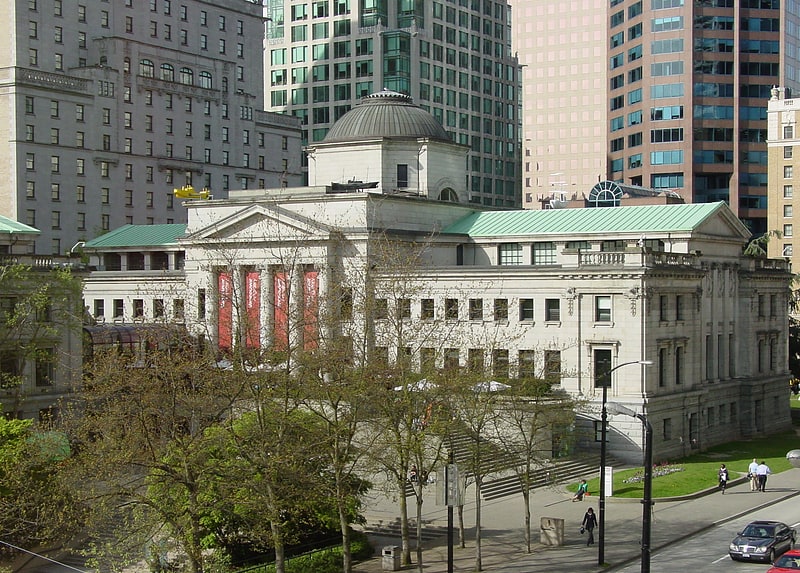
Artworks from British Columbia and beyond. The Vancouver Art Gallery is an art museum in Vancouver, British Columbia, Canada. The museum occupies a 15,300-square-metre-building adjacent to Robson Square in downtown Vancouver, making it the largest art museum in Western Canada by building size. Designed by Francis Rattenbury, the building the museum presently occupies was originally opened as a provincial courthouse, before it was re-purposed for museum use in the early 1980s. The building was designated as the Former Vancouver Law Courts National Historic Site of Canada in 1980.
The museum was opened to the public in 1931 in a building designed by architectural firm Sharp and Johnston. The museum expanded its first building once in 1950, before plans were undertaken to move the institution to the former provincial courthouse building. The museum was relocated to the provincial courthouse in 1983. Plans were undertaken by the museum in the late 2000s and 2010s to relocate the institution to a new facility in Larwill Park.
The Vancouver Art Gallery's permanent collection serves as a repository of art for the Lower Mainland region, and has approximately 12,000 works by artists from Canada, and around the world. In addition to exhibiting works from its collection, the museum has also organized and hosted a number of travelling arts exhibitions.[6]
Address: 750 Hornby St, V6Z 2H7 Vancouver
Rogers Arena
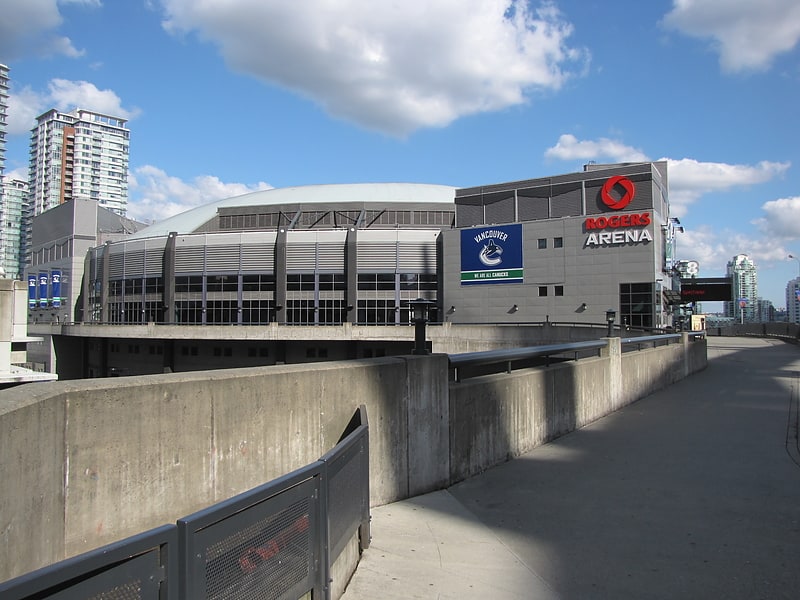
Arena in Vancouver, British Columbia. Rogers Arena is a multi-purpose arena located at 800 Griffiths Way in the downtown area of Vancouver, British Columbia, Canada. Opened in 1995, the arena was known as General Motors Place from its opening until July 6, 2010, when General Motors Canada ended its naming rights sponsorship and a new agreement for those rights was reached with Rogers Communications. Rogers Arena was built to replace Pacific Coliseum as Vancouver's primary indoor sports facility and in part due to the National Basketball Association 1995 expansion into Canada, when Vancouver and Toronto were given expansion teams.
It is home to the Vancouver Canucks of the National Hockey League, the Vancouver Warriors of the National Lacrosse League and the Vancouver Titans of the Overwatch League. The arena also hosted the ice hockey events at the 2010 Winter Olympics. The name of the arena temporarily became Canada Hockey Place during the Olympics. It was previously home to the Vancouver Grizzlies of the NBA from 1995 to 2001. The Grizzlies spent six seasons in Vancouver before relocating to Memphis, for the 2001–02 season.[7]
Address: Vancouver, 800 Griffiths Way
Capilano Suspension Bridge
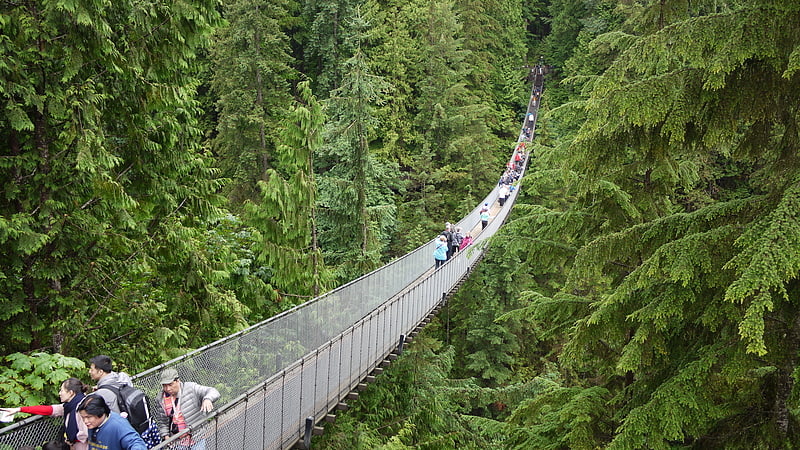
Landmark bridge perched in the treetops. The Capilano Suspension Bridge is a simple suspension bridge crossing the Capilano River in the District of North Vancouver, British Columbia, Canada. The current bridge is 140 metres long and 70 metres above the river. It is part of a private facility with an admission fee, and draws over 1.2 million visitors per year.[8]
Address: 3735 Capilano Rd, V7R 4J1 North Vancouver
Hastings Racecourse

Sports facility in Vancouver, British Columbia. Hastings Racecourse is a horse racing facility at Hastings Park, four miles from downtown Vancouver. Originally called East Park, it opened for business in 1889, making it Vancouver's longest continuously used professional sports facility. The racing operation is currently a wholly owned subsidiary of the Great Canadian Gaming Corporation which acquired the lease of the city-owned track in 2004.[9]
Address: 188 N Renfrew St, V5K 3N8 Vancouver
Lost Lagoon
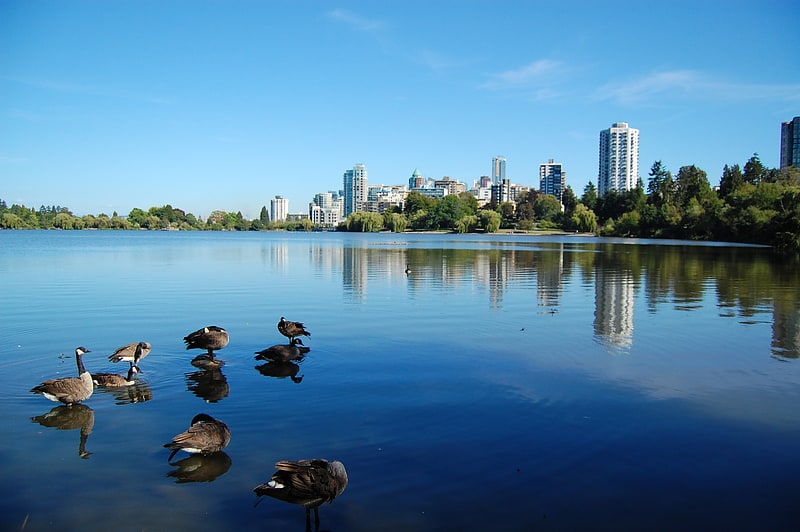
Body of water. Lost Lagoon is an artificial, captive 16.6-hectare body of water, west of Georgia Street, near the entrance to Stanley Park in Vancouver, British Columbia, Canada. Surrounding the lake is a 1.75 km trail. The lake features a lit fountain that was erected by Robert Harold Williams to commemorate the city's golden jubilee. It is a nesting ground to many species of birds, including non-native mute swan, Canada geese, numerous species of ducks, such as mallard ducks, and great blue herons. Also many turtles are usually resident on the northern shore.[10]
Address: Stanley Park, Vancouver
VanDusen Botanical Garden
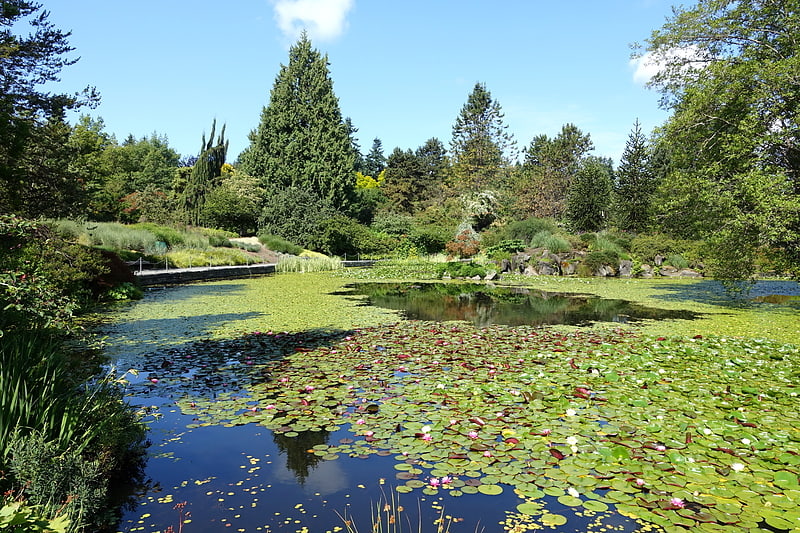
Botanical garden in Vancouver, British Columbia. VanDusen Botanical Garden is a botanical garden situated in Vancouver, British Columbia, in its Shaughnessy neighborhood. It is located at the northwest corner of 37th Avenue and Oak Street. It is named for local lumberman and philanthropist Whitford Julian VanDusen.[11]
Address: 5251 Oak St, V6M 4H1 Vancouver
Queen Elizabeth Park
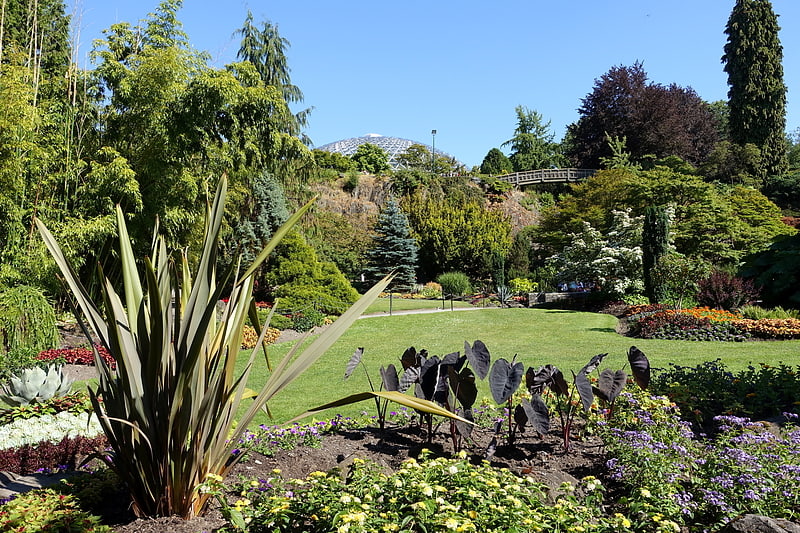
Seasonal gardens overlooking the city. Queen Elizabeth Park is a 130-acre municipal park located in Vancouver, British Columbia, Canada. It is located on top of Little Mountain approximately 125 metres above sea level and is the location of former basalt quarries dug in the beginning of the twentieth century to provide materials for roads in the city.[12]
Address: 4600 Cambie St, V5Y 2M4 Vancouver
Hollow Tree
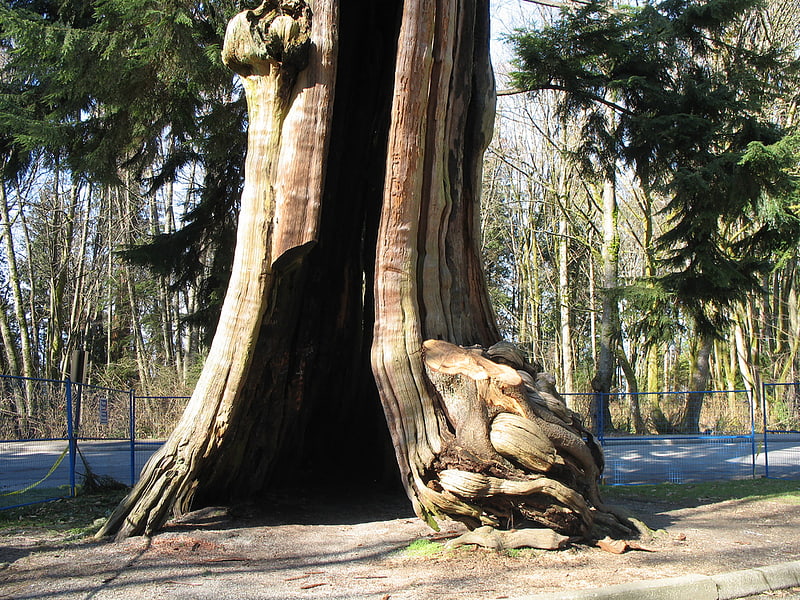
Scenic spot in Vancouver, British Columbia. Hollow Tree is a Western red cedar tree stump and a popular landmark in Stanley Park in Vancouver, British Columbia.[13]
Vancouver Maritime Museum
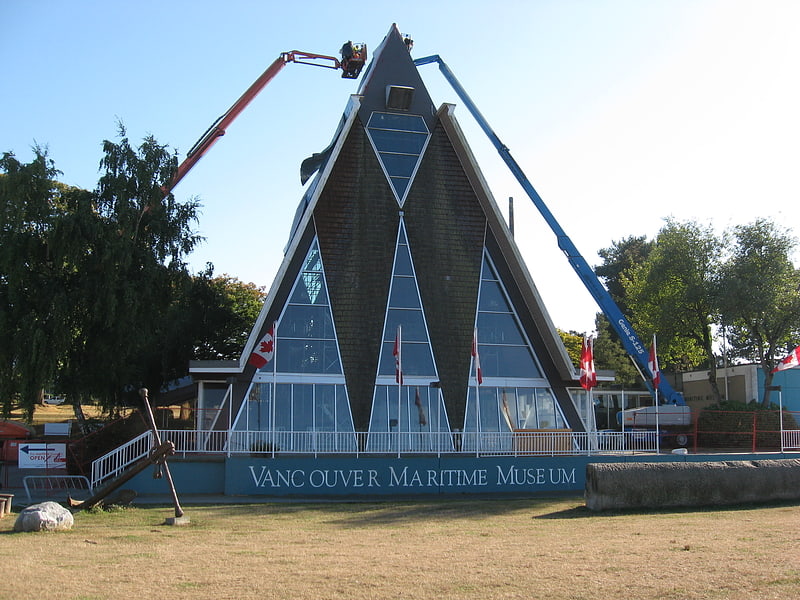
Nautical history of the Arctic and Pacific. The Vancouver Maritime Museum is a maritime museum devoted to presenting the maritime history of Vancouver, British Columbia, Canada, and the Canadian Arctic. Opened in 1959 as a Vancouver centennial project, it is located within Vanier Park just west of False Creek on the Vancouver waterfront. The museum is affiliated with CMA, CHIN, and Virtual Museum of Canada.[14]
Address: 1905 Ogden Ave, V6J 1A3 Vancouver
Burrard Street Bridge
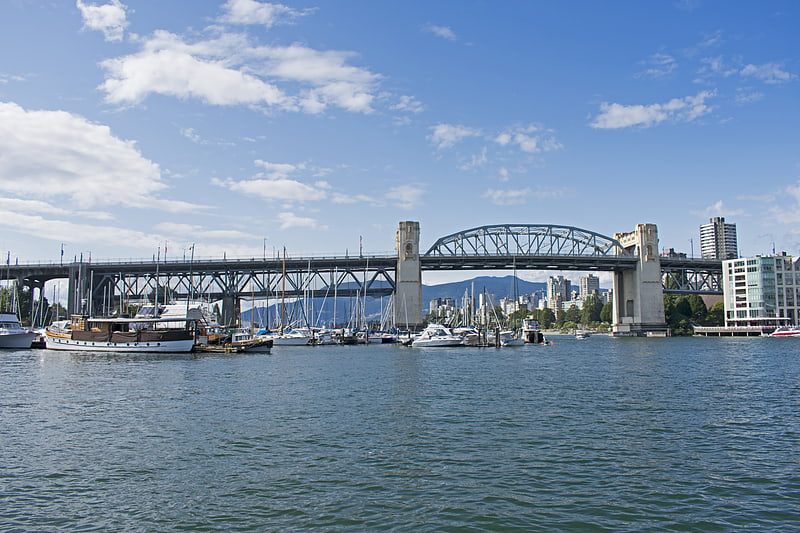
Truss bridge in Vancouver, British Columbia. The Burrard Street Bridge is a four-lane, Art Deco style, steel truss bridge constructed in 1930–1932 in Vancouver, British Columbia, Canada. The high, five part bridge on four piers spans False Creek, connecting downtown Vancouver with Kitsilano via connections to Burrard Street on both ends. It is one of three bridges crossing False Creek. The other two bridges are the Granville Bridge, three blocks or 0.5 km to the southeast, and the Cambie Street Bridge, about 11 blocks or 2 km to the east. In addition to the vehicle deck, the Burrard Bridge has 2.6 m wide sidewalks and a dedicated cycling lane on both sides.
The architect of the Burrard Street Bridge was George Lister Thornton Sharp, the engineer John R. Grant. The bridge's two close approach spans are Warren trusses placed below deck level, while its central span is a Pratt truss placed above deck level to allow greater clearance height for ships passing underneath. The central truss is hidden when crossing the bridge in either direction by vertical extensions of the bridge's masonry piers into imposing concrete towers, connected by overhead galleries, which are embellished with architectural and sculptural details that create a torch-like entrance of pylons. Busts of Captain George Vancouver and Sir Harry Burrard-Neale in ship prows jut from the bridge's superstructure (a V under Vancouver's bust, a B under Burrard's).
Unifying the long approaches and the distinctive central span are heavy concrete railings, originally topped with decorative street lamps. These pierced handrails were designed as a kind of visual shutter (stroboscopic effect), so that at a speed of 50 km/h motorists would see through them with an uninterrupted view of the harbour. The effect works at speeds from about 40 to 64 km/h.[15]
Address: Burrard St, Vancouver
Dr. Sun Yat-Sen Classical Chinese Garden
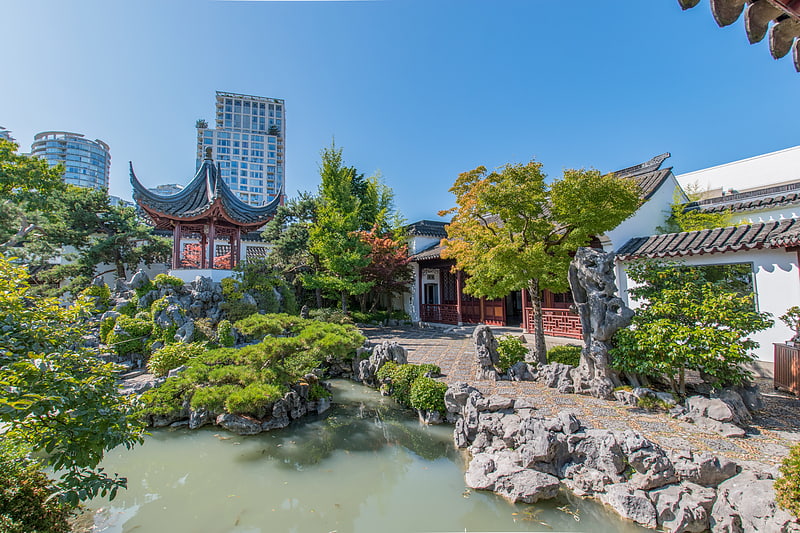
Tranquil green space with Taoist design. The Dr. Sun Yat-Sen Classical Chinese Garden is the first Chinese or "scholars" garden built outside of China, and is located in Chinatown in Vancouver, British Columbia, Canada. It is located at 578 Carrall Street and consists of a freely accessible public park and a garden with an admission fee. The mandate of the garden is to "maintain and enhance the bridge of understanding between Chinese and western cultures, promote Chinese culture generally and be an integral part of the local community."[16]
Address: 578 Carrall St, V6B 5K2 Vancouver
Swing bridge
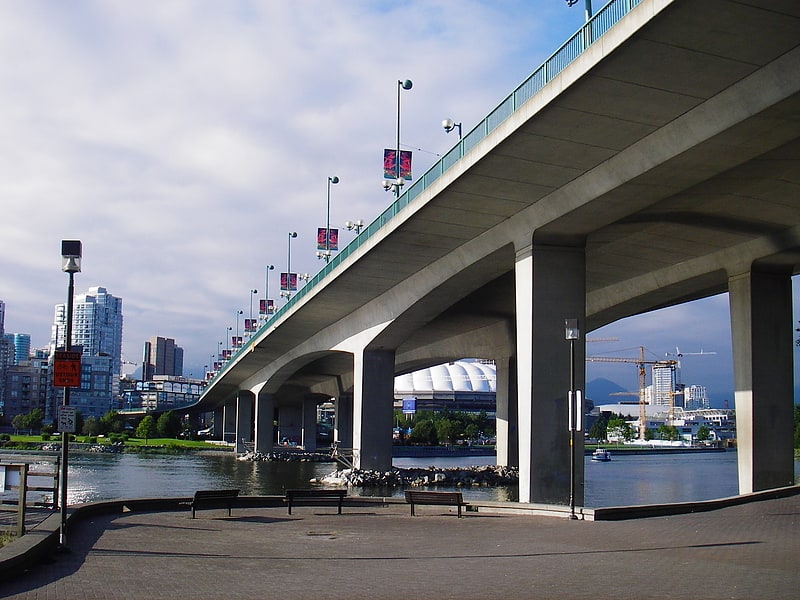
A swing bridge is a movable bridge that has as its primary structural support a vertical locating pin and support ring, usually at or near to its center of gravity, about which the turning span can then pivot horizontally as shown in the animated illustration to the right. Small swing bridges as found over canals may be pivoted only at one end, opening as would a gate, but require substantial underground structure to support the pivot.
In its closed position, a swing bridge carrying a road or railway over a river or canal, for example, allows traffic to cross. When a water vessel needs to pass the bridge, road traffic is stopped (usually by traffic signals and barriers), and then motors rotate the bridge horizontally about its pivot point. The typical swing bridge will rotate approximately 90 degrees, or one-quarter turn; however, a bridge which intersects the navigation channel at an oblique angle may be built to rotate only 45 degrees, or one-eighth turn, in order to clear the channel.[17]
Jack Poole Plaza

Jack Poole Plaza is a plaza in Vancouver's Coal Harbour neighborhood, in the British Columbia, Canada. The space is named after Jack Poole. The site is home to the cauldron that burned during the 2010 Olympic and Paralympic Winter Games.[18]
Address: 1055 Canada Pl., V6C 3T4 Vancouver
Lions Gate Bridge
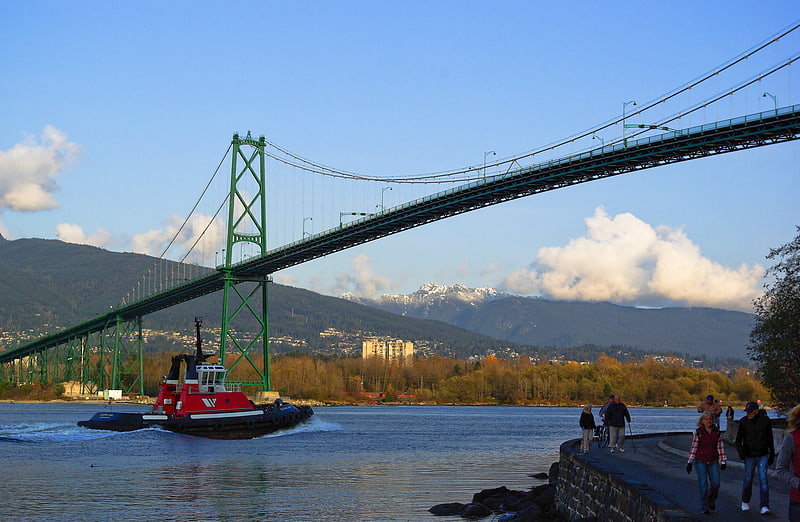
Suspension bridge in Vancouver, British Columbia. The Lions Gate Bridge, opened in 1938 and officially known as the First Narrows Bridge, is a suspension bridge that crosses the first narrows of Burrard Inlet and connects the City of Vancouver, British Columbia, to the North Shore municipalities of the District of North Vancouver, the City of North Vancouver, and West Vancouver. The term "Lions Gate" refers to the Lions, a pair of mountain peaks north of Vancouver. Northbound traffic on the bridge heads in their general direction. A pair of cast concrete lions, designed by sculptor Charles Marega, were placed on either side of the south approach to the bridge in January 1939.
The total length of the bridge including the north viaduct is 1,823 metres (5,981 ft). The length including approach spans is 1,517.3 metres (4,978 ft), the main span alone is 473 metres (1,552 ft), the tower height is 111 metres (364 ft), and it has a ship's clearance of 61 metres (200 ft). Prospect Point in Stanley Park offered a good high south end to the bridge, but the low flat delta land to the north required construction of the extensive North Viaduct.
The bridge has three reversible lanes, the use of which is indicated by signals. The centre lane changes direction to accommodate for traffic patterns. The traffic volume on the bridge is 60,000–70,000 vehicles per day. Trucks exceeding 13 tonnes (12.8 long tons; 14.3 short tons) are prohibited, as are vehicles using studded tires. The bridge forms part of Highways 99 and 1A.
On March 24, 2005, the Lions Gate Bridge was designated a National Historic Site of Canada.[19]
Address: 595 Burrard St # 1901, Vancouver
Museum of Vancouver
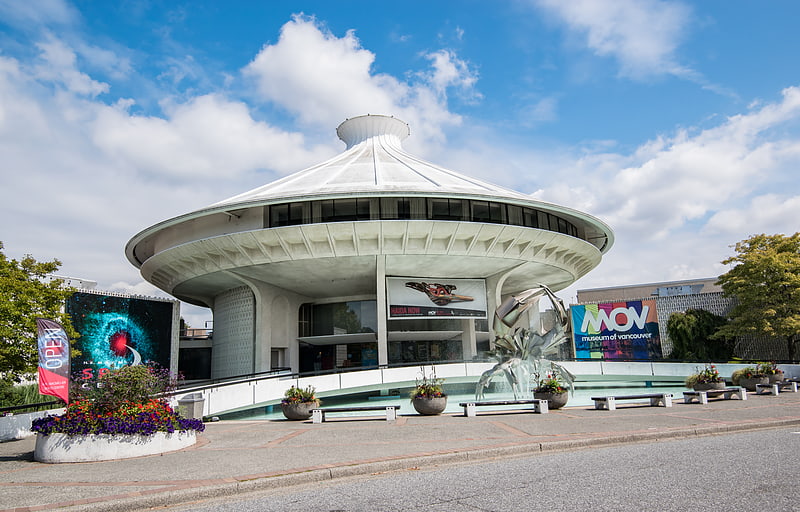
City history from First Nations to today. The Museum of Vancouver is a civic history museum located in Vanier Park, Vancouver, British Columbia. The MOV is the largest civic museum in Canada and the oldest museum in Vancouver. The museum was founded in 1894 and went through a number of iterations before being rebranded as the Museum of Vancouver in 2009. It creates Vancouver-focused exhibitions and programs that encourage conversations about what was, is, and can be Vancouver. It shares an entrance and foyer with the H. R. MacMillan Space Centre but the MOV is much larger and occupies the vast majority of the space in the building complex where both organisations sit as well as separate collections storage facilities in another building.[20]
Address: 1100 Chestnut St, V6J 3J9 Vancouver
Lighthouse Park
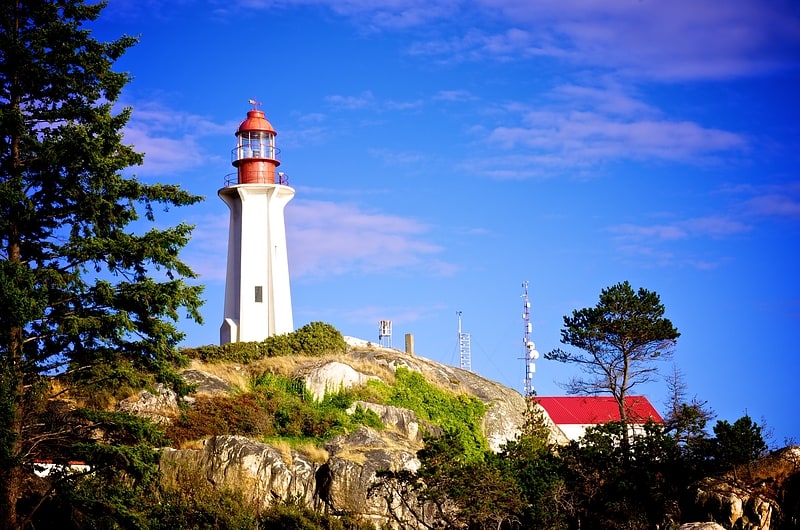
Park in West Vancouver, British Columbia. Lighthouse Park is a neighbourhood park located in a residential area in West Vancouver. It is a popular tourist attraction for visitors to Vancouver as it is a National Historic Site of Canada. It is a well-maintained park, and is open year-round throughout all four seasons. The park is known for the Point Atkinson Lighthouse, located at the southernmost tip of the peninsula. The park is made up of 75 hectares of mostly virgin rainforest, and was founded in 1792. The District of West Vancouver maintains and operates the park and permits visitors from 7:00 a.m. to 10:00 p.m. Visitors to this park can enjoy the various beginner level hiking trails, as well as bring their dogs for a walk or have lunch along the rocks of the beach near the Lighthouse. There are various picnic benches scattered throughout the trails of the park, yet none near the beach and the lighthouse itself.[21]
Address: Beacon Lane, V7W 1K5 Vancouver
Point Atkinson Lighthouse

Scenic spot in West Vancouver, British Columbia. Point Atkinson Lighthouse is a lighthouse erected on Point Atkinson, a headland in southwestern British Columbia named by Captain George Vancouver in 1792, when he was exploring the Pacific Northwest in the ship Discovery. The first wooden lighthouse went into service in 1875 and was replaced by a reinforced concrete structure in 1914.[22]
Address: Lighthouse Park, Vancouver
Nitobe Memorial Garden
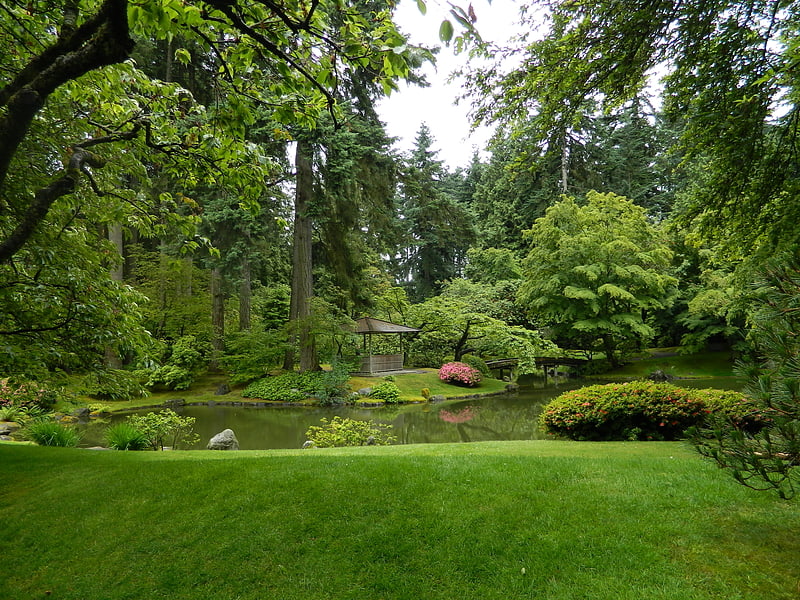
Traditional Japanese landscaping and tea. The Nitobe Memorial Garden is a 2+1⁄2-acre traditional Japanese garden located at the University of British Columbia, just outside the city limits of Vancouver, British Columbia, Canada. It is part of the UBC Botanical Garden and Centre for Plant Research.
It honours Japanese author, educator, diplomat, and politician Nitobe Inazō (1862–1933), who died in Victoria, British Columbia (now the sister city of Nitobe's home town Morioka), and whose goal was "to become a bridge across the Pacific".
The garden has been the subject of more than fifteen years' study by a UBC professor, who believes that its construction hides a number of impressive features, including references to Japanese philosophy and mythology, shadow bridges visible only at certain times of year, and positioning of a lantern that is filled with light at the exact date and time of Nitobe's death each year. The garden is behind the university's Asian Centre, which is built with steel girders from Japan's exhibit at Osaka Expo.[23]
Address: 1895 Lower Mall, V6T 1Z4 Vancouver
Christ Church Cathedral

Cathedral in Vancouver, British Columbia. Christ Church Cathedral in Vancouver, British Columbia, Canada, is the second cathedral church of the Anglican Diocese of New Westminster of the Anglican Church of Canada. A place of worship in Greater Vancouver, the cathedral is located at 690 Burrard Street on the northeast corner of West Georgia Street, directly across from the Fairmont Hotel Vancouver in Downtown Vancouver.[24]
Address: 690 Burrard St, V6C 2L1 Vancouver
Siwash Rock
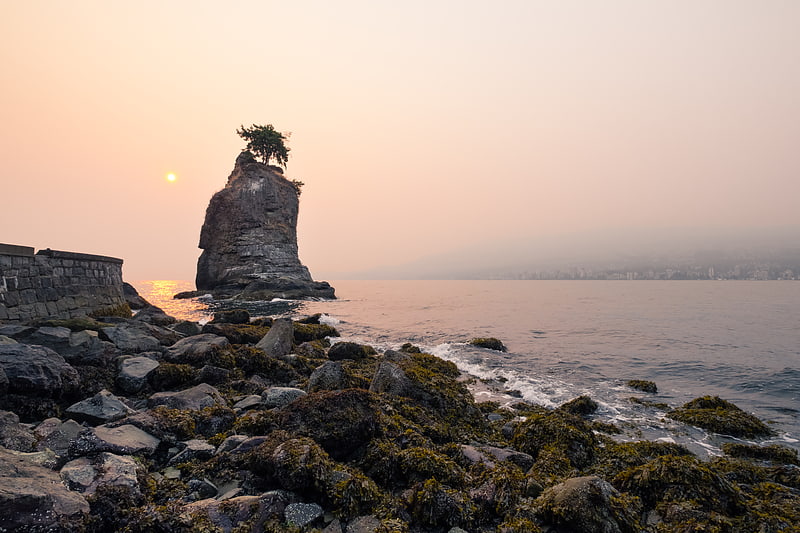
Landmark in Vancouver, British Columbia. Siwash Rock is a rock outcropping in Vancouver, British Columbia, Canada's Stanley Park. A legend among the Indigenous Squamish people surrounds the rock. It is between 15 and 18 metres tall. It became known to mariners as Nine Pin Rock for its resemblance to a bowling pin.[25]
Address: Stanley Park, Vancouver
Vancouver City Hall
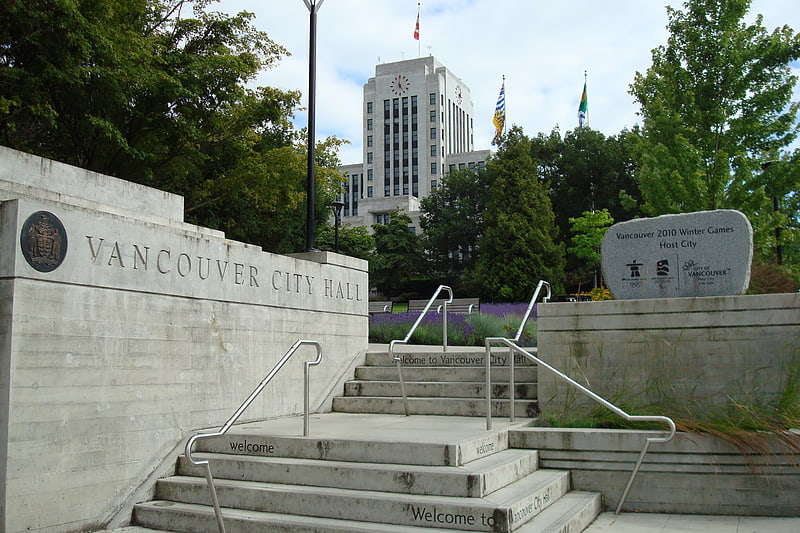
Building in Vancouver, British Columbia. Vancouver City Hall is home to Vancouver City Council in Vancouver, British Columbia, Canada. Located at 453 West 12th Avenue, the building was ordered by the Vancouver Civic Building Committee, designed by architect Fred Townley and Matheson, and built by Carter, Halls, Aldinger and Company. The building has a twelve-storey tower with a clock on the top.
The building is served by the Broadway–City Hall station on SkyTrain's Canada Line.[26]
H. R. MacMillan Space Centre

Museum in Vancouver, British Columbia. The H.R. MacMillan Space Centre, is an astronomy museum located at Vanier Park in Vancouver, British Columbia, Canada. The museum was opened on October 28, 1968 containing a Planetarium Star Theatre. Today the museum includes an exhibit gallery and demonstration theatre where public lectures and events are hosted. The museum shares the building with the Museum of Vancouver. Next to the building is the Gordon MacMillan Southam Observatory.[27]
Address: 1100 Chestnut St, V6J 3J9 Vancouver
BC Sports Hall of Fame
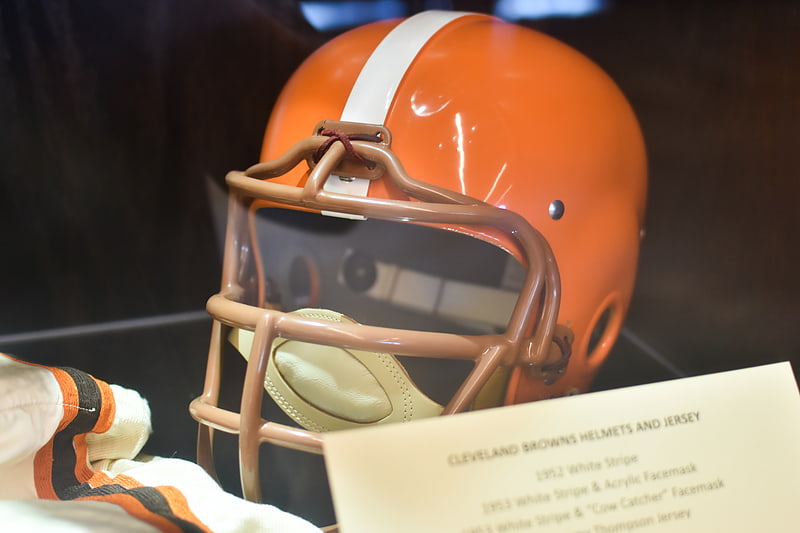
Museum in Vancouver, British Columbia. The BC Sports Hall of Fame is a museum located in BC Place Stadium, at Gate A, the main entrance to the stadium, in Vancouver, British Columbia, Canada. It collects, preserves, studies and interprets materials that relate to British Columbia's sport history, and allows researchers, writers, media members and sport historians to gain access to and appreciate BC's sporting heritage.
The organization has amassed an extensive artifact and archival collection of artifacts and archival documents related to sports. The museum features galleries on BC sportspeople Terry Fox, Rick Hansen and Greg Moore. It also has several multi-sport galleries including a gallery on Aboriginal sport, the BC professional sports teams, the 1954 British Empire and Commonwealth Games, and "In Her Footsteps", a gallery focused on women in sport.[28]
Address: 777 Pacific Blvd, V6B 4Y8 Vancouver
Chehalis Cross
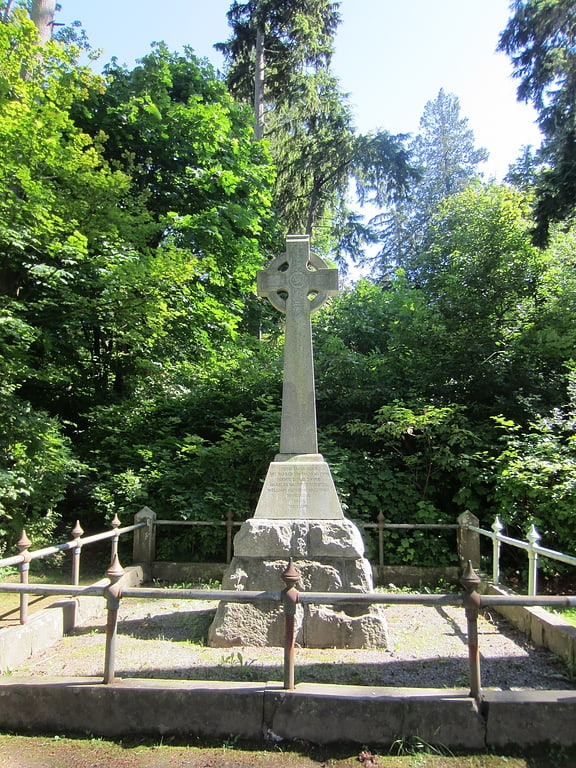
Monument in Vancouver, British Columbia. The Chehalis Cross, or Chehalis Monument, is a Celtic cross memorial commemorating the eight people who died when the tugboat Chehalis sank off Stanley Park. The monument is installed west of Brockton Point in Vancouver, British Columbia.[29]
Hinge Park
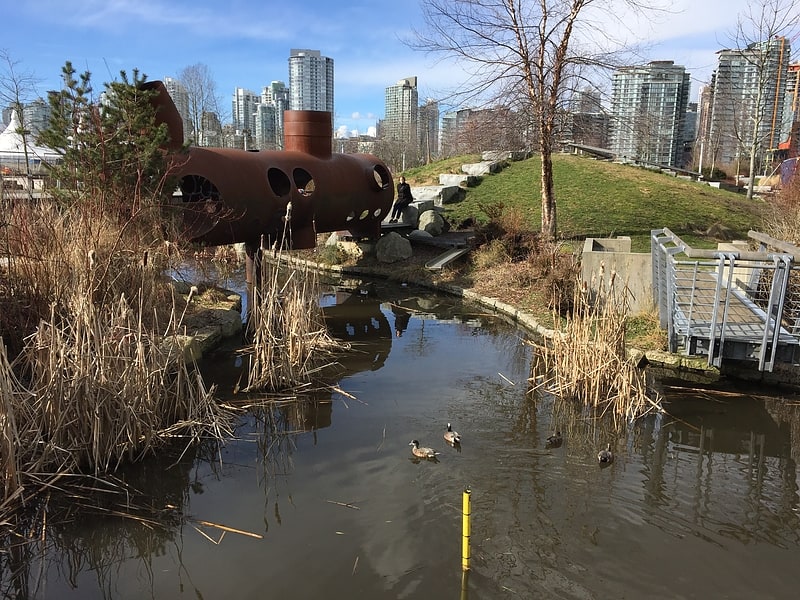
Park in Vancouver, British Columbia. Hinge Park is a naturalized wetland park in the city of Vancouver, British Columbia. Hinge Park covers 2.3 acres and also connects to Habitat Island which covers around 1.5 acres. The park includes a trail in Habitat Island, a walking/biking trail along the shoreline of False Creek, public art installations, picnic tables, benches, docks, a children's play area, a bridge constructed from sewer pipe, a water pump with metal runnels at the top of a small hill, and the Olympic Village dog park.[30]
PNE Forum

Indoor arena in Vancouver, British Columbia. The Forum is an indoor arena in Vancouver, British Columbia, Canada located on the grounds of the Pacific National Exhibition.[31]
Address: 2901 Hastings St E, V5K 5J1 Vancouver
Cambie Bridge

Girder bridge in Vancouver, British Columbia. The Cambie Bridge is a six-lane symmetric, precast, varying-depth-post tension-box girder bridge spanning False Creek in Vancouver, British Columbia. The current bridge opened in 1985, but is the third bridge at the same location. Often referred to as the Cambie Street Bridge, it connects Cambie Street on the south shore of False Creek to both Nelson and Smithe Streets in the downtown peninsula. It is the easternmost of False Creek's fixed crossings; the Burrard and Granville bridges are a little more than a kilometre to the west, and the new Canada Line SkyTrain tunnel is built just west of the Cambie Bridge.[32]
Holy Rosary Cathedral
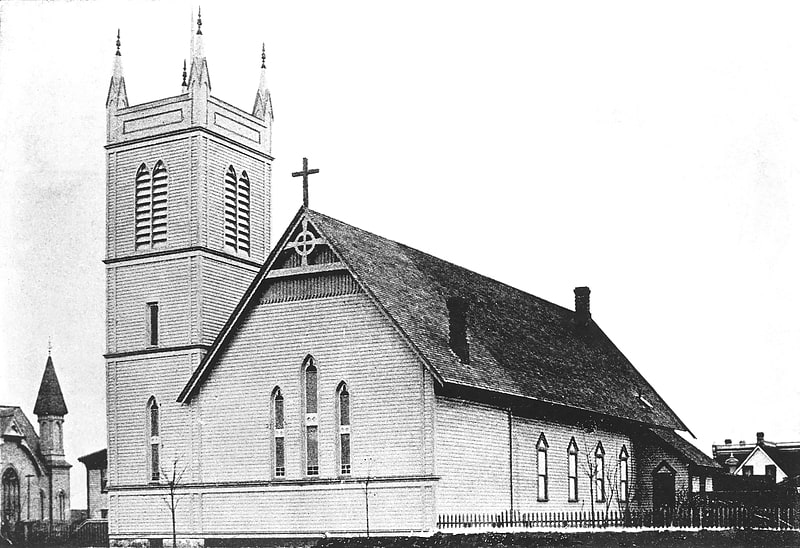
Cathedral in Vancouver, British Columbia. The Metropolitan Cathedral of Our Lady of the Holy Rosary, commonly known as Holy Rosary Cathedral, is a late 19th-century French Gothic revival church that serves as the cathedral of the Roman Catholic Archdiocese of Vancouver. It is located in the downtown area of the city at the intersection of Richards and Dunsmuir streets.
The construction of the cathedral began in 1899 on the site of an earlier church by the same name. It opened on the Feast of the Immaculate Conception on December 8, 1900, was blessed the day after, and was consecrated in 1953. The style has been described as resembling the medieval Chartres Cathedral in France. The church was elevated to the status of cathedral in 1916. It is listed on the Vancouver Heritage Register and is a legally protected building.[33]
Address: 646 Richards St, V6B 3A3 Vancouver
Woodward's Building
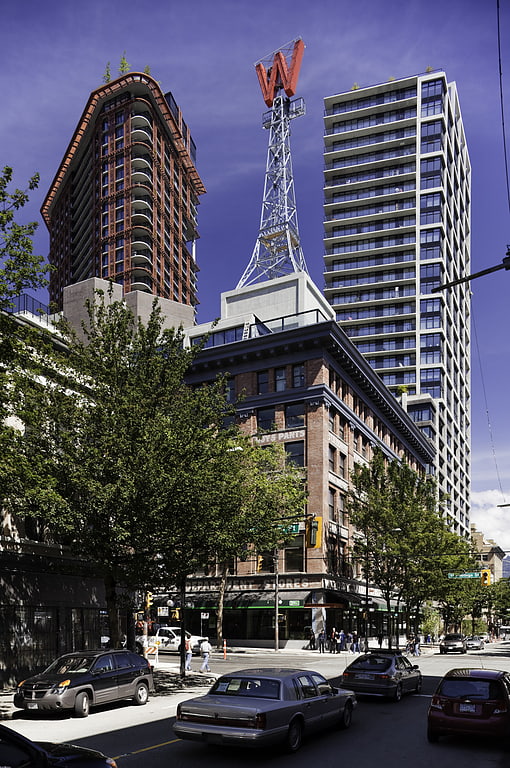
The Woodward's Building is a historic building in the Downtown Eastside of Vancouver, British Columbia, Canada. The original portion of the building was constructed in 1903 for the Woodward's Department Store when that area of Cordova Street was the heart of Vancouver's retail shopping district. At one time, this was the premier shopping destination in Vancouver. The store was famous for its Christmas window displays and its basement Food Floor, and the "W" sign at the top of the building was a distinctive landmark on the Vancouver skyline.
Since the bankruptcy of Woodward's in 1993, the building remained vacant except for a housing occupation in 2002 that initiated the redevelopment process. The redevelopment was seen by many as a key to revitalizing the Downtown Eastside. Still, the demolition of the structure in 2006 and redevelopment of the site has been met with much local resistance from the neighbourhood's existing residents. Woodward's redevelopment is complete, with many residents and businesses in the buildings.[34]
Japanese Canadian War Memorial

War memorial in Vancouver, British Columbia. The Japanese Canadian War Memorial is located at Stanley Park in Vancouver, British Columbia.[35]
Address: Stanley Park, Vancouver